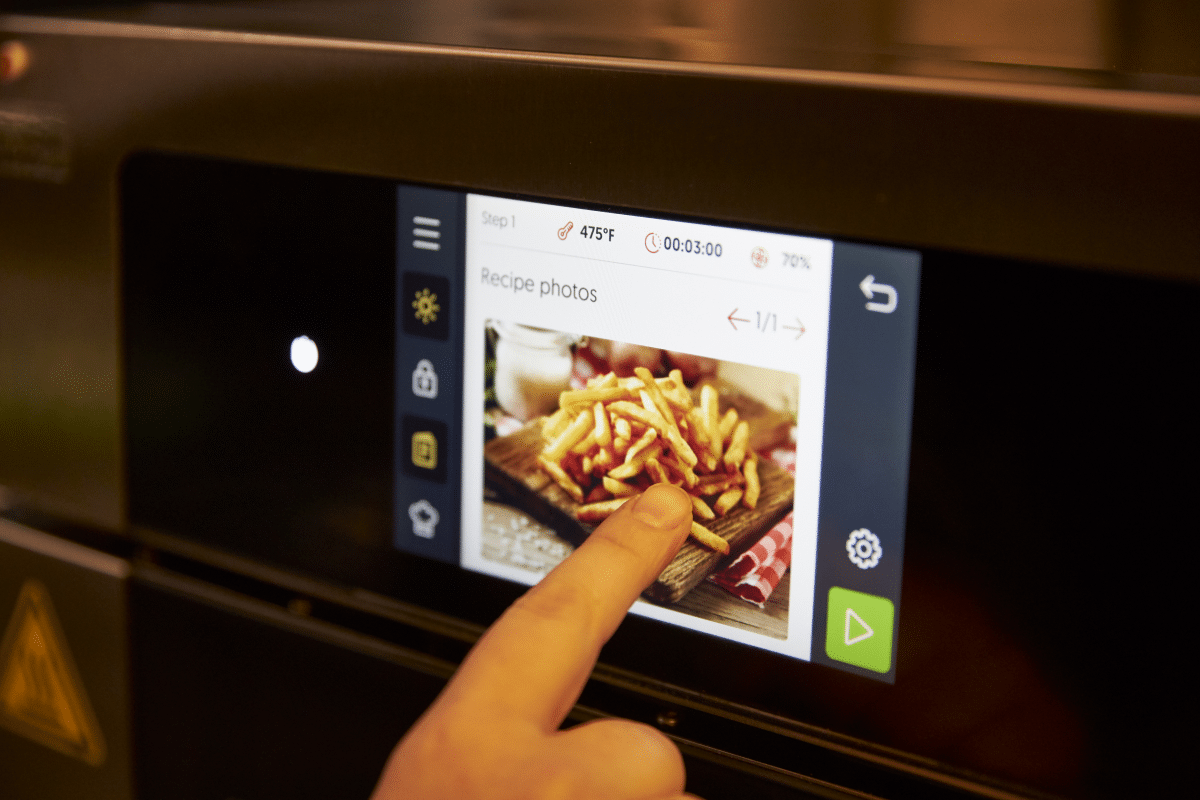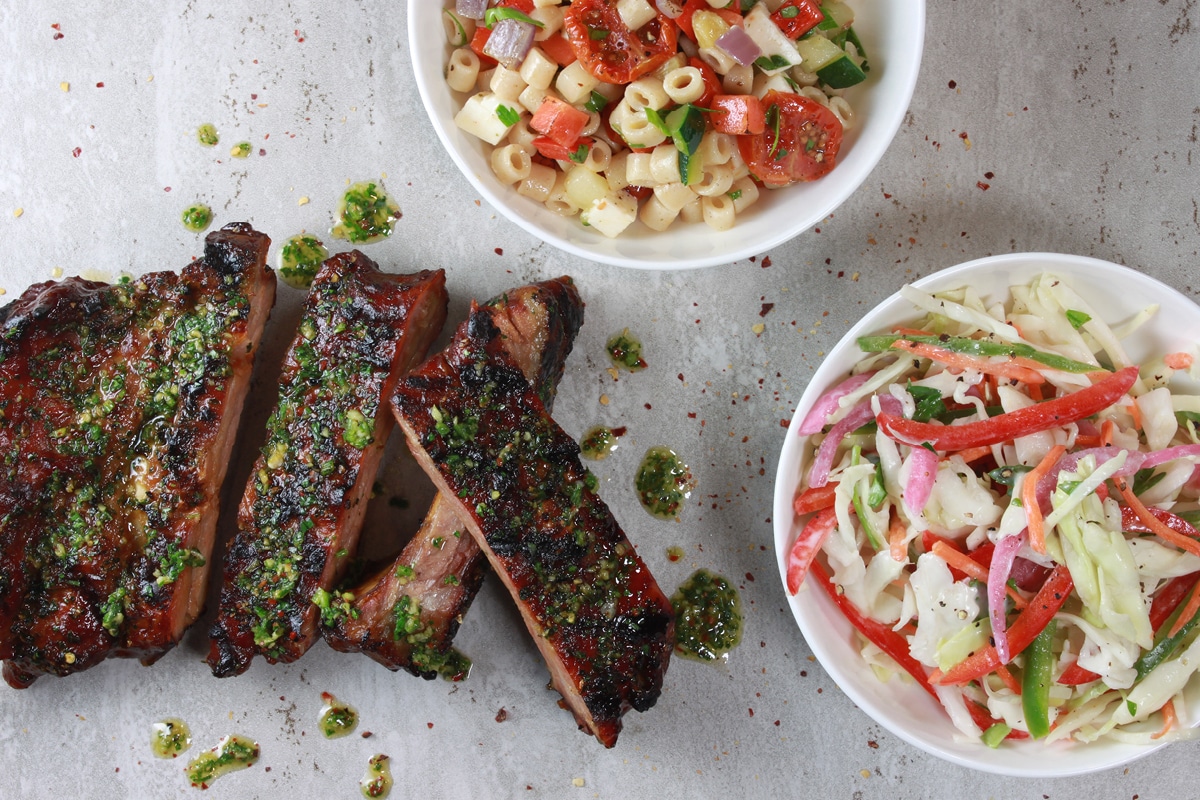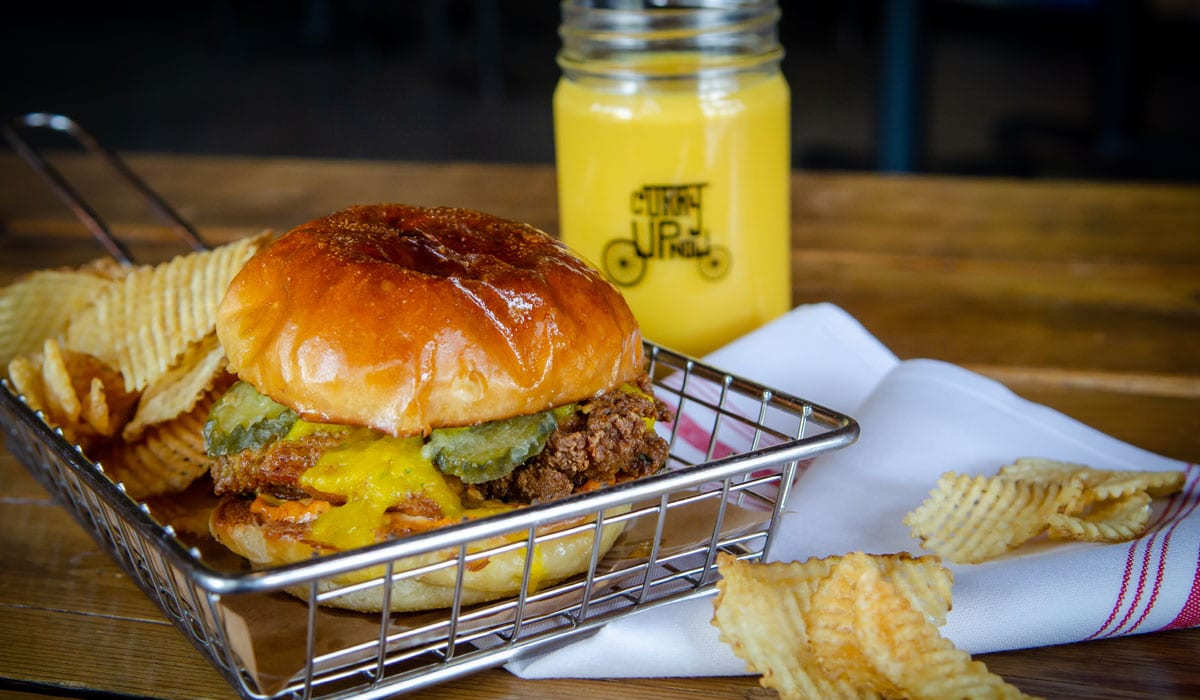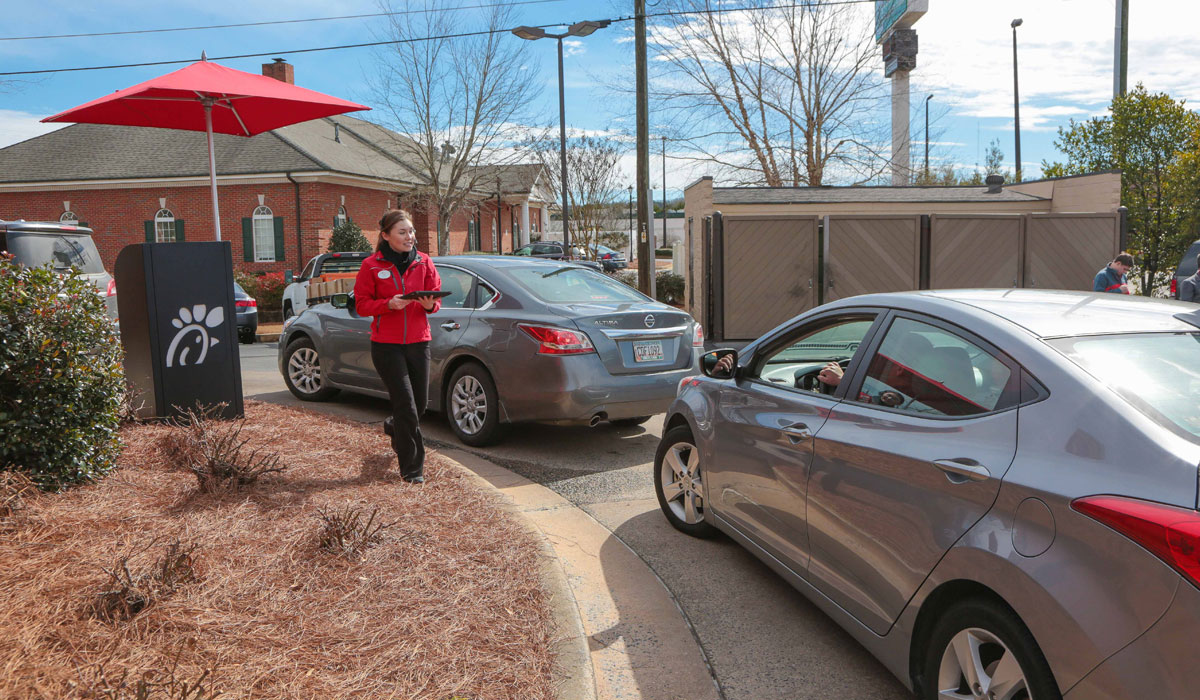The COVID-19 pandemic has slugged on for six months now. Two truths remain—counter-service brands are in better shape than other sectors; and those with drive thrus are a step further.
Location technology company Bluedot recently released its second “State of What Feeds Us” report (check out the first here). In it, the company found 74 percent of people have visited the drive thru the same amount or more often than usual since COVID-19 landed. That’s a 43 percent leap from April.
It proves what’s fast become a crystal byproduct of the pandemic: Consumers are leaning on drive thrus to avoid crowds and contact.
But this brings the industry to an inflection point, especially as more and more fast casuals and upstarts enter the drive-thru fray. Chains like Chipotle, Noodles & Company, and even Shake Shack, have touted heightened drive-thru strategies for a post-coronavirus world. Chipotle opened net 37 restaurants in Q2. Twenty-one of those included the so-labeled “Chipotlane” mobile order pickup window. And the company projects 60 percent of its new restaurant growth this year will showcase the feature. Next year, the mix will exceed 70 percent. Chipotle even said it was going to hire 10,000 people over the coming months to support expansion.
Cowen analyst Andrew Charles wrote in a note he sees Chipotle expanding the drive-thru format from 100 stores to 1,000 by 2025, which would account for 33 percent of the company’s operating profits. He said they offer enhanced profitability, expedited throughput, and richer data collection.
“We argue Chipotle is uniquely positioned to benefit with this new format given digital sales that were an impressive 20 percent of sales pre-COVID-19, while the concept does not have any traditional/legacy drive-thru operations that would require customer behavior to be altered,” Charles wrote.
Noodles & Company, meanwhile, was on the verge of reigniting unit growth before COVID-19 curbed non-essential spending. With store-level trends on the rise, the 456-unit chain expects to get back on track well before 2022. However, the changing climate will bring order-ahead, drive-thru pickup windows to 70 percent of new locations.
And beyond Shake Shack’s creative 2021 drive-thru design, which features three lanes, the company is investing in walk-up windows and dedicated delivery courier pickup areas. Starbucks is building “several hundred” Pickup stores in the next 12–18 months and working on drive-thru enhancements, such as handheld devices for employees to take orders in line.
As evident, what you’re likely to see near- to mid-term for restaurants is a development march into suburban markets to capitalize on this drive-thru race. Starbucks noted in its Q2 recap that customer visits continue to shift from urban cafes to suburban drive thrus, and it’s a safe bet the company’s real estate agility will play out in real time.
READ MORE:
How Drive-Thru Restaurants Can Thrive in the Age of Social Distancing
Smaller Footprints, More Drive Thru: Restaurant Design in a COVID World
For Chipotle, outside of cities is where Chipotlanes will blossom. These stores have pushed digital mix of 60 percent in recent weeks, with about two-thirds coming from order ahead and pickup. It’s a higher-margin, more consumer-friendly channel than third-party delivery.
Additionally, of the 13 Chipotlanes in the company’s comp system, sales ran more than 10 percent higher from the same opening period compared to traditional units, while more recent openings during COVID-19 are 30 percent above average stores.
All of these chains, sans Shake Shack, have mentioned relocating and remodeling units as well to take advantage. The bet many restaurants are making is that while socially distant trends might fade, or adjust, consumers’ love affair with convenience and contactless will not. Once you’ve had a frictionless, omnichannel experience, there’s no going back.
The notion surfaces a fresh challenge. What’s the right drive-thru setup, and what will separate the winning experiences now that it’s quickly become an even denser field? Should you go the order-ahead-only route, like Chipotle and Noodles & Company? Or do you attempt to blend it all together, like Shake Shack?

Bluedot found that the average speed of drive-thru service has been four minutes, 15 seconds during the pandemic. That equates to only two cars completing the drive thru before it becomes frustrating for consumers.
The latter stems from another data point: 81 percent of respondents said anything more than 10 minutes was too long for a drive-thru experience.
One of the reasons Chick-fil-A has been so successful with drive thru speaks to the above dynamic. Drive thru isn’t all about speed. Across the 10 brands studied in QSR’s Drive-Thru Performance Study (conducted before COVID-19), the average speed of service slowed by about 21 seconds, from 234.08 seconds in 2018 to 255.34 in 2019.
And Chick-fil-A was No. 10, at 322.98 seconds. Yet still, the 2,500-unit brand ranked best in both order accuracy (at 94 percent, 4 percentage points higher than No. 2 Burger King) and customer service (scoring top marks in eye contact, pleasant demeanor, smiling, saying “please,” and being “very friendly”).
The why behind this could serve as a valuable lesson going forward into a drive-thru-dominated era. Firstly, Chick-fil-A’s service time was slowest simply because it was the busiest by a good distance. A full 77 percent of its drive-thru experiences had three or more cars in line, while 35.5 percent had six or more cars in line. To put that in perspective, McDonald’s was the second-busiest drive thru, and only 41.8 percent of its drive thrus had three or more cars and 9.1 percent had six or more.
Yet here’s the kicker: Slowest or not, 56 percent of “mystery shoppers” rated their experiences in the Chick-fil-A drive thru as “fast,” two percentage points above the industry average. And the auditors reported they were “satisfied” or “highly satisfied” by nearly 95 percent of Chick-fil-A’s drive thru experiences versus 79 percent sector wide.
It suggests delivering drive-thru experience remains a circular opportunity. There’s as much of a customer experience hook as greeting dine-in guests. And this is going to be doubly the case in a post-coronavirus world where more and more customers are pulling up.
Chick-fil-A famously meets diners with “face-to-face” ordering in the drive-thru line, which has changed a bit in recent times. Now, customers put their credit card in a portable device without touching anything. Chick-fil-A also built handwashing stations.
But the overall aim hasn’t changed. Chick-fil-A can greet guests sooner, basically upon arrival, and then boost throughput by giving staff more time to prepare each order.

On a less concrete note, though, guests perceive the experience more favorably than if they waited behind a long line of cars, without talking to anybody for minutes on end.
During COVID-19, as dining-room staffing needs naturally lowered, some Chick-fil-As expanded to two or three drive-thru lanes, using cones, canopies, and other pop-up decor. Operators extended WiFi capabilities.
The chain devised a check-point system of sorts to keep the consumer journey flowing, from getting your order taken at the front to paying at step two, to pickup at the end. And so forth.
Again, it’s not all that different from how the dining room used to work.
In-N-Out is a category leader in this practice, too. Recognizing the drive-thru line as a common bottleneck, the burger chain has long sent order takers down the queue with hand-held devices.
In July, Starbucks CEO Kevin Johnson said the feature was coming to its footprint. Drive thru, combined with mobile order-and-pay, accounted for nearly 90 percent of the company’s Q3 sales volume—a full 30 percent higher than normal.
COO Roz Brewer said adding handheld point-of-sale devices would “bust the line,” a retail term that refers to employees working up the line to take orders on mobile tablets faster than counter staff can operate a stationary terminal.
A simple goal: Better throughput as Starbucks puts orders in a queue faster, gets out-the-window times down, and delivers food to consumers quickly. And, like the Chick-fil-A effect, a more satisfied customer that isn’t entirely reliant on speed of service.
Bluedot asked consumers about the safety element of drive thrus. Having order takers walk the line does bring up the question of whether or not it will be more unsettling for guests. This is why Chick-fil-A features contactless payment and makes sure employees clearly wear masks (cow themed in places). Guests can also order via the app or online, which is the focus of the Chipotle model.
Bluedot said 29 percent of respondents said they feel safer when sanitation and safety information is posted at the drive-thru window, followed closely by less contact or zero contact with staff (25 percent).
In April, the figures were 38 percent for contactless and 23 percent for posting information.
So what you’re seeing is a more comfortable consumer mostly OK with limited human contact. You just have to invest in visual cues.
The change in behavior stems from guests practicing their own safety precautions (easy access to masks, experiences going out), lockdown fatigue, and restaurants getting better at sharing and promoting new safety features.
The winning formula appears to be a combination of contactless options alongside signage and employee practices that get the message across. Some guests are going to be more guarded than others. But everyone can agree multiple points of purchase are better than fewer ones. And the less mystery when it comes to what’s happening, the better. This can be as true in the drive thru as it is walking in the lobby.
Brizo FoodMetrics’ data shows 310,790 “independent” U.S. restaurants with takeout or drive-thru capabilities operating today. The company defines the pool as concepts with four or fewer units that have received customer reviews within the last six months.

The rise of curbside
As expected, curbside pickup continues to experience higher usage today compared to early COVID-19. Restaurants are adopting the practice in greater numbers.
Sixty-two percent of Bluedot’s respondents said they have used curbside pickup at a restaurant the same amount as before or more often than before in the last month.
Forty percent said they’ve used curbside pickup at a restaurant more than usual. In April, the figure was just 27 percent.
Akin to drive thru, as more operators onboard the option, consumer expectations will climb. In this case, there’s been an increase in importance when it comes to staff wearing a mask and gloves at curbside, Bluedot said.
Me not needing to leave my car
- First study: 31 percent
- Current: 27 percent
You can see here, once more, how consumers are loosening up their lockdown behaviors a bit.
Staff meeting me at curbside with mask and gloves
- First study: 18 percent
- Current: 26 percent
It seems the honeymoon period is over. Now that curbside is a relatively common channel, guests aren’t accepting the novelty of it. They’re judging one experience versus another. That’s true from a competitive angle as well as a repeat visit one.
Minimal or zero contact and interaction with staff
- First study: 30 percent
- Current: 22 percent
The same thread as before: The more time passes, the more guests trust restaurant workers. There’s no question some users will have the reverse experience. But if a brand delivers, and the guest is no worse because of it, fears will ease on some level. And then it comes down to the experience and meeting needs beyond just safety measures.
Carryout choices
There is even less patience for carryout and in-store pickup than drive thru. Customers don’t want to wait in line with other customers. As much trust is being credited to employees of restaurants, the same isn’t true of other patrons. A vast majority of people list other guests as their No. 1 concern with dining out in a COVID world, not the restaurant itself.
Bluedot reported that 67 percent of guests view waiting six minutes or more as too long and frustrating for in-store pickup.
Sixty-five percent of people have picked up in-store at a restaurant the same number or more often than before in the last month, the company added. That’s a 10 percent increase from the start of April.
Three out of four respondents, or 72 percent, said they experience fear and/or anxiety over walking into a store/restaurant. That’s down from 80 percent in April.
Clearly, guests are increasingly willing to walk in and grab their food. Yet a restaurant might lose that same customer if they enter a crowded lobby and find it difficult to maintain their distance. You could say it defeats the contactless purpose. Consumers didn’t really like waiting for pickup before. Now, doing so taps into a host of other issues, from personal safety to guilt over leaving the house and making a seemingly bold choice. “I had to wait in line with 20 other people,” is a much different story to relay than, “I walked in, grabbed the food, spoke to nobody, touched nothing, and left.”
Chipotle, Cava, and hordes of other chains have rolled pickup shelves to units to streamline the process.
Apps on the rise
Bluedot discovered a significant increase in mobile app usage to purchase food and essentials. The company said 64 percent of respondents have downloaded at least one or more new apps to buy food from restaurants, grocers, and other essential stories. It’s up close to 15 percent from April.
All of this is connected. Apps to order food for contactless carryout. Apps to get drive-thru orders up and paid before you head over. It’s customer service, served digitally.
App usage
Same amount or more often than before
- First study: 85 percent
- Current: 88 percent
More often or much more often than before
- First study: 42 percent
- Current: 50 percent
Same amount as before
- First study: 39 percent
- Current: 39 percent
The gains, Bluedot said, are coming from those who previously used apps less often and are now using them much more often—an unlock to get food the way people want today.
Sixty-four percent of people said they prefer notifying restaurants of arrival via the app or texting. Of which it’s an even split between automated check-ins via the app or texting the restaurant directly.
Forty-nine percent said they’ve downloaded two or more apps—up just slightly from 45 percent in the last study.
The safety question
In Bluedot’s study, employees not wearing masks was, by far, the No. 1 reason respondents said they would not return to a restaurant. Sixty-two percent ranked wearing masks as the most important safety measure (there were 28 to choose from). Nearly 40 percent of people also said they feel more safe in the drive thru compared to delivery, third-party delivery, and carryout. Curbside pickup was second.
What’s safest?
Drive thru
- Overall: 38 percent
- Women: 39 percent
- Men: 37 percent
Curbside
- Overall: 21 percent
- Women: 23 percent
- Men: 19 percent
In-store pickup
- Overall: 9 percent
- Women: 9 percent
- Menu: 9 percent
One thing to note, women perceive drive thru as three-and-half times safer than in-store pickup.
This spreads across regions, too (safety ranking):
Drive thru
- Midwest: 43 percent
- West: 41 percent
- South: 38 percent
- Northeast: 29 percent
Curbside
- Midwest: 24 percent
- West: 20 percent
- South: 21 percent
- Northeast: 20 percent
In-store pickup
- Midwest: 11 percent
- West: 7 percent
- South: 11 percent
- Northeast: 10 percent
When it comes to waiting, Bluedot summarized that the closer guests get to stepping into a physical store, the less waiting is expected and tolerated.
Percentage of consumers who feel frustrated waiting 10 minutes or more:
- Drive thru: 81 percent
- Curbside: 83 percent
- In-store: 86 percent
Gender differences
Willing to wait more than 10 minutes at a drive thru
- Women: 20 percent
- Men: 16 percent
Rank minimal wait times as one of the largest safety factors
- Women: 30 percent
- Menu: 39 percent






